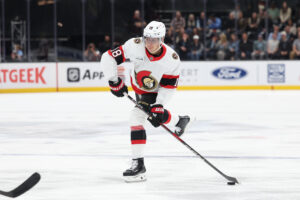Over the last several months, I have been crunching numbers, trying to solve the many questions of NHL player development. With that, we here at Last Word On Hockey will be starting a new series on how to properly develop prospects from all different spots throughout the draft.
NHL Player Development of Top Three Picks
From 2005-2015, there has been 24 draft picks used on forwards from North American junior teams in the top 3. The focus was directly on North American prospects for the sake of comparing stats. I separated those 24 forwards from the rest of the top 3 picks in that span. Then, I looked at their DY-1 stats, the season before they get drafted, and their draft year (DY) stats. I averaged out their points per game in their DY-1, DY and beyond, if necessary, and colour-coded them. The four sections were “well-above average,” “above average,” “below average” and “well-below average.”
Based on the sections they landed on before they played 15 or more games in an NHL season, they were separated into categories. The categories were “Forwards deemed NHL Ready,” “Forwards nearly NHL Ready,” “Slightly Rushed,” “Rushed,” “Forced,” “Teams were Patient,” and “Teams were way too patient.” There were three forwards who landed in the “forced” category. Those three forwards were Jordan Staal, Gabriel Landeskog, and Matt Duchene.
NHL Player Development of Jordan Staal
Jordan Staal, one of four brothers to have been given an NHL contract, was drafted 2nd overall by the Pittsburgh Penguins in 2006. Playing in the OHL, Staal recorded 0.424 points per game in his DY-1 season. That mark placed him well-below average when compared to other top-three picks in their DY-1 seasons. In fact, he ranks 27th of the 28 forwards taken in the top-three, from 2005-2015. He followed that up with exactly one point per game in his draft year, which placed him, once again, well below the average. He placed 26th out of those same 28 forwards. Despite posting poor junior stats, Staal was still given an NHL role immediately out of the draft.
How was Staal used?
In his first season with Pittsburgh, he played 81 games and averaged just under 15 minutes of ice time per game. Despite the relatively small role, Staal still produced 29 goals and 13 assists for 42 points. As for analytics, they weren’t yet recorded at this time. However, he did finish top-15 for Selke Trophy voting. He also finished in the top-three in the Calder Trophy voting.
In his second season, he played a full 82 games, averaging a much larger role with 18:16 time on ice per game. Despite the increased role, Staal only scored 12 goals and 16 assists for 28 points. Analytically, he scored poorly in even-strength offence above replacement (EVO) with a -3.4 mark. As for even-strength defence above replacement (EVD), he scored a decent 1.2 mark. His goals above replacement (GAR) score was negative, scoring a -1.8 score.
Good Player Development Decision by Pittsburgh
Despite Staal’s sophomore slump and clear regression from his rookie year, Pittsburgh stayed the course and gave him an even bigger role. Once again, Staal played 82 games, this time averaging just under 20 minutes of ice time a game. It paid off in spades, as Staal would go on to record 22 goals and 27 assists for 49 points, a new career-high at that point. His analytics improved drastically, with a 2.3 EVO and a 5.0 EVD. He also recorded 6.7 GAR, much better than the year before. Staal would go on to be generally consistent, recording around 40 to 50 points a season, though never truly being considered elite. He would be a Stanley Cup champion, but to this day has never won any individual trophies.
NHL Player Development of Gabriel Landeskog
Having played in the OHL, Gabriel Landeskog was taken 2nd overall by the Colorado Avalanche. He recorded 0.754 points per game in his DY-1 season, coming in at a well-below average. He ranked 23rd out of the 28 forwards that was compared to Staal above. In his draft year season, he recorded a 1.245 point per game mark, ranking 24th and once again being placed at a well-below average. Despite the struggles with point production, similar to Staal, Colorado gave him an immediate NHL role right out of the draft.
How was Landeskog used?
In his rookie year, Landeskog played 82 games and averaged 18:37 of ice time a game. That’s a pretty substantial role for a young kid. With it, he scored 22 goals and 30 assists for 52 points. Analytically, he played extremely well, with an 11.3 EVO, 2.5 EVD, and an 11.5 GAR. He won the Calder Trophy.
[pickup_prop id=”4451″]
In his second season, he saw an increased role. However, he only played 36 games, as it was the lock-out shortened season, with an additional 12 games missed. He averaged 19:20 time on ice in those 36 games, with 9 goals and 8 assists for 17 points. His analytics took a hit, with a -0.3 EVO, 1.4 EVD, and a 2.4 GAR.
With the struggles faced in his sophomore season, plus the fact he played less than 40 games, Landeskog’s role was reduced slightly. He played 81 games and averaged 18:41 time on ice. Landeskog would record 26 goals and 39 assists for 65 points. He also scored a 12 EVO, 5.4 EVD, 3.1 WAR and 16.2 GAR. The only hardware he has received to this point in his career is that Calder Trophy. He, Nathan MacKinnon, and Mikko Rantanen combine to be one of the best lines in hockey over the last two years.
NHL Player Development of Matt Duchene
Duchene was drafted out of the OHL at 3rd overall by the Colorado Avalanche. In his DY-1 season, Duchene posted a 0.781 point per game mark, placing him in the well-below average category yet again. He ranked 22nd out of the same 28 forwards mentioned above. As for his draft year, Duchene recorded 1.386 points per game, again placing below average. He ranked 22nd out of 28 yet again in his draft year. Despite those struggles, he was given an NHL role directly out of the draft.
[pickup_prop id=”3674″]
How Was Duchene Used?
In his rookie year, Duchene played in 81 games and averaged 17:44 of ice time per game. In that role, Duchene managed to score 24 goals and 31 assists for 55 points. His advanced stats were decent, as he managed a 4.5 EVO, -0.6 EVD and a 12.4 GAR. He finished in the top-three of Calder Trophy voting.
In his second season, his role was slightly increased, as he played 80 games averaging 18:57 of time on ice. He would score 27 goals and 40 assists for 67 points. All of his advanced metrics improved, other than his EVD, which fell to -1.3. He recorded a 13.5 EVO and a 15.3 GAR, which is excellent.
In his third season, injuries held him to just 58 games. He averaged a mere 16:17 minutes of ice time per game. He recorded a disappointing 14 goals and 14 assists for 28 points. His advanced analytics was also poor, as he recorded a 0.6 EVO, 1.3 EVD and a 4 GAR. Duchene is arguably the most inconsistent year-to-year player out of the three mentioned, as he has gone on to record two 70+ point seasons and three seasons below 45 points from this point forward.
NHL Player Development: Where Are They Now?
All three of these players are notable and well known amongst casual fans, though none of them are elite, except maybe for Landeskog. Landeskog is the only one to stick with the team that drafted him, as Duchene was traded to the Ottawa Senators. After Ottawa, he was dealt to the Columbus Blue Jackets. When the season came to an end, he signed with the Nashville Predators. Meanwhile, Staal ended up leaving Pittsburgh for the Carolina Hurricanes, where he has remained since the 2012-13 season.
What Makes Landeskog the Best of the Bunch?
Landeskog is arguably the best of the three players mentioned, depending on who you ask. Landeskog ranks second among the three forwards looked at in this article in EVO per 60 minutes, WAR per 60 minutes, and GAR per 60 minutes in his career, behind Duchene. He ranks first in EVD per 60 minutes. In the metrics where he is behind Duchene, they are very close. In fact, the largest margin between the two lies in their EVO per 60 stat, where the difference is 0.07. When it comes to raw stats, Landeskog has 475 points in 653 games, while Duchene has 597 in 816 games. That makes their per game point totals extremely close, but gives Duchene the edge. Where Landeskog beats Duchene in a landslide is in his defensive abilities.
How did Colorado Develop Landeskog?
Colorado has built a Stanley Cup contender. Landeskog and Duchene, you could argue, is what set the foundation in place. The Duchene deal reeled in spectacular assets, most notably Samuel Girard and Bowen Byram. It helped that they had a poor season, netting them Cale Makar, ahead of the Duchene deal. Nathan MacKinnon was then granted a larger role, as Duchene held the number one center role before he was dealt. MacKinnon breaking out and developing great chemistry with Landeskog, along with the breakout of Mikko Rantanen, has helped Landeskog take that next step. He’s looking more and more like a 70+ point producer year-to-year.
As for Duchene, every team he lands on struggles mightily. Ottawa became a dumpster fire upon his arrival. Columbus did well but failed to get through the second round in his short time with the team. Now, with Nashville, they’ve been beyond disappointing, and continue to struggle this season. Jordan Staal, on the other hand, has played for two really good teams. Because of that, he has never truly gotten an opportunity to lead a team on his own. At this stage of his career, that ship has already sailed.
All advanced stats via Evolving-Hockey






